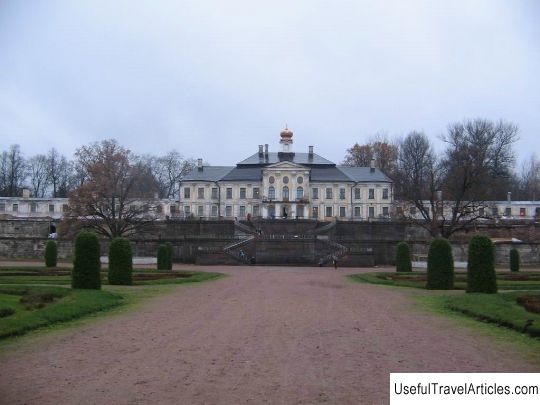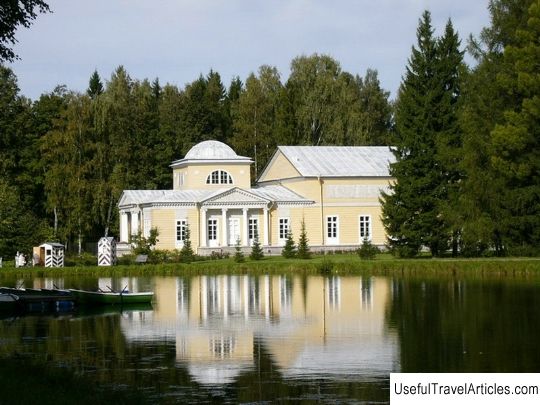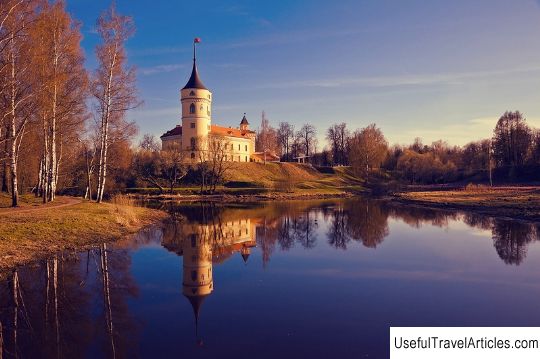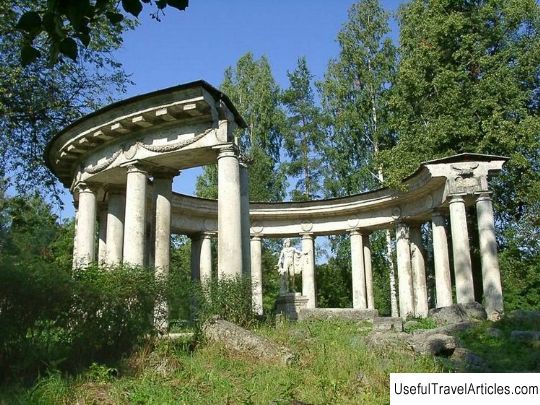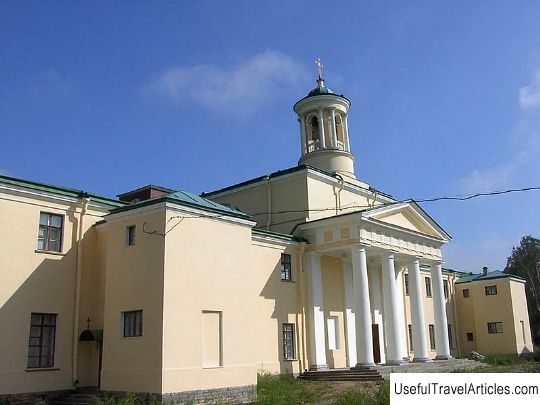Pavlovsk Palace and Park description and photos - Russia - St. Petersburg: Pavlovsk
Rating: 7,6/10 (1432 votes) 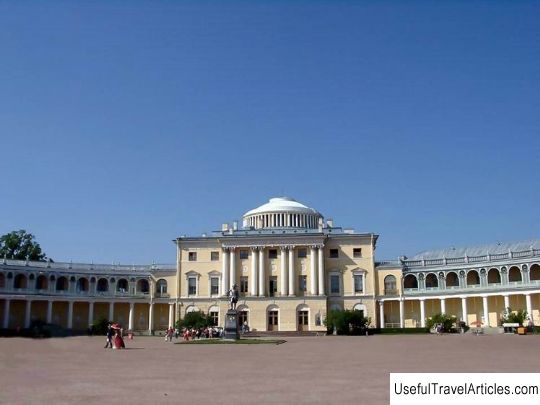
Pavlovsk Palace and Park description and photos - Russia - St. Petersburg: Pavlovsk. Detailed information about the attraction. Description, photos and a map showing the nearest significant objects. Photo and descriptionPavlovsk Palace and Palace Park, owned by Empress Maria Feodorovna, wife of Paul I, is one of the most beautiful and richest palace suburbs of St. Petersburg. In the magnificent palace you can see the living rooms of the empress and the interiors of the 18th-19th centuries, and the park is a real work of landscape design. The Grand Duke in PavlovskOnce upon a time there was a wooden Novgorod fortress. By the 18th century, several Finnish villages located in these territories had become part of the Russian Empire. But Pavlovsk, as we know it now, arose in 1777, when Catherine II presented these lands to her son, heir to the throne Pavel Petrovich. At first, the grand ducal couple - Pavel Petrovich and Maria Feodorovna - lived here in a village style. Two small wooden houses were built - Paulust for him and Marienthal for her. Around them, the Grand Duchess immediately laid out flower beds - she loved and knew how to grow flowers. At her expense in 1781 here, according to the project D. Quarenghi a church dedicated to her saint - Mary Magdalene is being built. This is the first stone building in Pavlovsk. The Grand Duchess and then the Empress took part in decorating this temple. She was a jack of all trades, and was not only engaged in traditional women's embroidery, but also knew how to work on a lathe. For this temple, she personally carved out of ivory and amber the sacrament bowls and chandeliers. In 1786, a real door was erected here. The architect was a Scotsman Charles Cameron . Under his supervision, a whole park was laid out with pavilions in the Palladian style, combining antique and Italian motives. One of the most interesting surviving pavilions of this time is the Temple of Friendship - round and decorated with Doric columns. However, it became the “Temple of Friendship” later, initially the pavilion was dedicated to Empress Catherine II and was decorated with her bronze bust. In the mid-1790s, the relationship of the long-standing adult heir with his mother finally deteriorated. He understands that she will not allow him to participate in state affairs - and demonstratively moves away from the court. Another estate, Gatchina, became his personal residence. His small courtyard moved here and until Catherine's death Pavel lived exclusively in Gatchina. Pavlovsk in 1788 he officially gives to his wife Maria Feodorovna. Pavlovsk is not abandoned, although the main focus is on Gatchina. People come here to relax and have fun. In 1797, a small "amusing" fortress Bip was built, built according to all the rules of fortification: with ravelins, flushes and bastions. The fortress was equipped with real cannons and was officially assigned to the military department. A drawbridge led to it, which rose at night, and at noon a cannon shot was heard from the fortress. Why it was called "Bibs" or "Beep" - no one knows, probably it was some kind of inner joke of the grand ducal couple. A century later, this name began to be deciphered as "Paul's Big Toy" - and there was a certain meaning in this. This building now houses a small private hotel. Another "medieval" pavilion is the round Pil-tower , which is being built on the shore near the mill - it is arranged next to one of the "cold baths", that is, baths. Having ascended the throne, Paul did not forget the possessions of his wife. Big receptions are being held here, the palace and the pak continue to be improved. And with the death of Paul I and the accession of her son Alexander I , the Dowager Empress finally makes Pavlovsk her personal residence. Pavlovsk under Maria Feodorovna The first third of the 19th century is the heyday of Pavlovsk. Empress Maria Feodorovna lives here almost all the time. She does not take an official part in public affairs, although her influence is enormous: in fact, she is the head of the entire imperial house, her children live throughout Europe, they turn to her on all difficult issues. Maria Feodorovna chooses a special type of activity for herself - she undertakes all state charity and has been doing it for her for many years. Numerous hospitals, almshouses, orphanages, schools, boarding houses, charitable societies - all this is part of the "department of the empress." Pavlovsk directly affects her activities - for example, she arranges an almshouse at the palace church of St. Mary Magdalene. Her palace continues to change. In 1803, a fire broke out and the palace was damaged, but almost immediately it was rebuilt under the direction of the architect A. Voronikhin. Maria Fyodorovna settles on the first floor - her rooms are also decorated by A. Voronikhin. Appeared in the palace Gonzaga Gallery - decorated with panoramic landscape frescoes by artist P. Gonzaga, the palace gallery facing the river. But most of all the Empress cares about the park. She erects here a mausoleum in memory of Paul I - "Spouse-Benefactor", as well as a monument to her daughter, Princess Elena Pavlovna, who died early, Elena Pavlovna . The marble column is erected in honor of her closest friend and educator of her children, Charlotte Lieven. Maria Feodorovna keeps Dutch cows and goes to the Dairy to milk them. In the park, on specially arranged beautiful pastures, sheep graze pastorally. Gardening and floriculture is one of her old hobbies. On all her travels, she always inspects all gardens and flower beds and talks with gardeners about botany. Seeds, bulbs, and seedlings are sent to her from all over Europe. She arranges the Pink Pavilion - a small, elegant pavilion with a classic look with porticoes, surrounded by a rose garden. This place is becoming her favorite. And under the windows of her rooms in the palace " Private garden " is being broken. It is divided into two parts - front, with roses and other flowers, and "botanical", where the empress grows rare plants and is engaged in botanical research. Under Maria Feodorovna, until 1828, Pavlovsk lived a rich court life. Balls and magnificent theatrical festivals in nature are held here, Emperor Alexander comes with Empress Elizaveta Alekseevna. But with her death, life slowly dies down. Pavlovsk after Maria Feodorovna In 1836, the very first horse-drawn railway opens here - it connects Pavlovsk and Tsarskoe Selo ... A new building appears in the park. According to the project A. I. Stakenschneider a railway station is being built, connected to a concert hall and a restaurant - this is both a railway station and an entertainment complex. It regularly hosts concerts of a symphony orchestra conducted by Johann Strauss . Unfortunately, the whole complex has not survived to this day - it was destroyed during the war. Restoration projects are now being developed. In the second half of the 19th century, Pavlovsk became the property of the great prince. Konstantin Nikolaevich , the grandson of Maria Fedorovna. He opens a museum of antiquities and an art gallery in the palace to the public. During his reign, a theater also appeared next to the station, and a monument to Paul I was opened in front of the palace. In the park, he erected another monument to his early deceased son Vyacheslav . Horticultural traditions continue under him. The famous gardener Ernest Bode works here, who is engaged in the park and the huge greenhouse complex. After the revolution, Pavlovsk becomes a museum. At that time the famous architect Sigismund Dombrovsky was the keeper of the palace and the park. In the 1930s, a significant part of the decorations from here were sold abroad, and in 1941 they were taken out in several batches to various museums. During the retreat, the Germans disfigured the park: they cut down a significant part of the trees, the palace itself and most of the pavilions were burned and blown up. Restoration began immediately after the war. Of all the palace suburbs of Leningrad, Pavlovsk was the first to be restored. Pavlovsk Museum There are several exhibitions in the palace. These are the ceremonial halls and living rooms of Maria Feodorovna, an exhibition dedicated to the women's world of the 19th century, which tells about the empress herself and about other women of her time. A separate exposition is devoted to the history of costume - here you can see the dresses of Russian empresses from Maria Feodorovna to Alexandra Feodorovna and much more. The interior of the palace church has been restored and there is an exhibition of precious church utensils of clouds. The photo exhibition is dedicated to the revival of Pavlovsk in the post-war years. Also preserved in the palace is the memorial museum of A. Zelenova, the director of the museum during the war years, during which the evacuation of valuables took place and who managed to achieve the beginning of restoration work. The huge Palace Park is divided into seven main districts. Four pavilions are part of the museum's exposition and admission is by ticket. These are the Pink Pavilion, the Temple of Friendship, the Cold Bath and the Peel Tower. Separate entrance to Maria Feodorovna's own garden, as well as to the territory of the recently revived Bode Gardening. Here are planted those plants that once grew under the imperial family, and planted an orchard with old varieties. Interesting factsOne of the very first park structures - a memorable marble column - is called "The End of the World". But it does not remind of the apocalypse, but simply that the landscaped part of the park ends here. In the Bip fortress, Maria Feodorovna arranged the first school in Russia for deaf children. Maria Feodorovna followed so that the life of the surrounding peasants corresponded to the lush palace surroundings. For example, she gave a prize for "the most well-groomed cow" - a silver cup holder. Notes
                                    We also recommend reading Cathedral of Santa Maria Assunta (Cattedrale di Santa Maria Assunta) description and photos - Italy: Venice Topic: Pavlovsk Palace and Park description and photos - Russia - St. Petersburg: Pavlovsk. |



